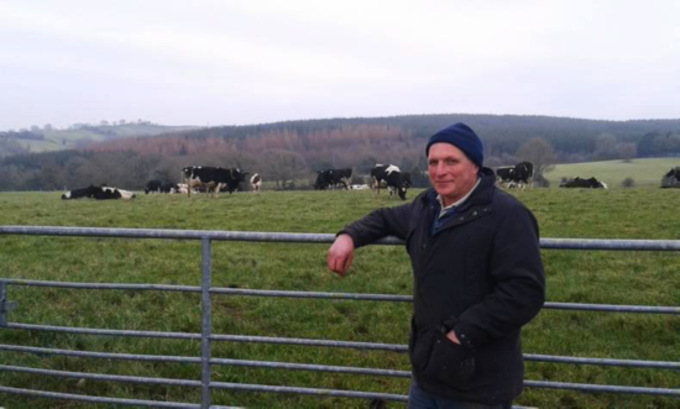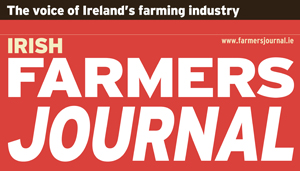Wet weather adding to the problems in Tyrone
15th August 2015

Robin Clements on his Co Tyrone farm.
The rain over the last five weeks has led to Tyrone farmers having to house their herds last week.
Two Dairylink Ireland project farmers based in Co Tyrone will have welcomed the improvement in weather conditions on their farms this week.
On both Kevin McGrade and Robin Clements’ farms, all cows had been housed last week as a result of the heavy rain making grazing impossible. For example, on Wednesday of last week ground conditions were already waterlogged when 26mm of rain fell in a 16-hour period. This was a real concern for Kevin and Robin as even before Wednesday’s rain the grass plant was starting to close down and turn yellow on both farms. A lot of second-cut silage is also still standing in the area as a result of excessive rainfall in the past fortnight, with contractors and farmers having been delayed from getting these crops in. Even with the better weather forecast this week, the ground will require some time to dry before the silage can be removed.
Robin Clements - managing wet conditions
Dealing with wet conditions is nothing new for Robin Clements, who maintains flexibility is the key on his farm. Getting cows off the land when it turns wet is critical for him because if paddocks get damaged or severely poached, they take much longer to dry out. Robin explains his approach to handling a prolonged wet spell on his farm in two stages.
Stage 1: Cows and in-calf heifers are housed on the farm, with the heifers on round bale silage and the cows on silage and 1kg of meal.
Last week, 30% of the herd had been dried off and more cows are due to be dried off this week. With the herd generally in late lactation, production is not critical, so silage and 1kg of meal is enough to maintain cow condition. From a cost perspective, Robin admits it is much more expensive than when the herd is grazing, with cows eating nearly 10 bales per day. However, he says: “I really have no option on this farm. The soil type and high rainfall in the area is a limiting factor, and generally this happens every year on the farm. Luckily this year it has happened when the herd is in late lactation, so production will not really be affected.”
Stage 2: Managing the increased average farm cover when conditions improve and cows return to grazing.
While grass growth has been slow on the grazing platform during the wet period, at an average of 30kg DM/ha/day since cows have been housed, average farm cover has increased over the 10-day period, and now stands at 1,000kg DM/ha available (2,500kg DM/ha total cover). A number of paddocks have covers over 1,500kg DM/ha available (3,000kg DM/ha), and these will have to be cut and baled as soon as conditions allow. This week, Robin has started cows grazing again using an on/off approach as ground conditions are still wet. He has targeted paddocks with lower than normal pre-grazing cover to ensure that the cows clean out the paddock.
Kevin McGrade – adapting to excessive rainfall
Similar to Robin, Kevin McGrade farms outside Dromore, Co Tyrone, where excessive rainfall has caused havoc with grazing and silage making on the farm. On/off grazing has helped manage the conditions, but Kevin maintains that when there is no break in the rainfall the cows must be moved indoors full-time. The herd has been housed day and night for eight days over the wet weather, but at the start of this week Kevin got them out again using on/off grazing to minimise poaching.
“We only grew 20kg/ha/day last week on the grazing platform, which is what I expected, but grass looks yellow and has lost its vigour,” explains Kevin.
The herd is now 60% dry and he intends to get back to grazing full-time this week if conditions improve. Some pre-cutting will be used to get the grazing platform back on track in terms of grass quality. Currently the cows are milked once per day, and calving is due to start in September.
Kevin explains: “Thankfully cows are either in late lactation or dry on the farm, so no concentrate is required to maintain cow condition with the good-quality silage bales available to us. Had the cows been in mid-lactation, for example, it would have been an early start to winter for us with the added cost of concentrate required to maintain production.”
Despite the difficult grazing conditions on both these farms, Kevin and Robin recognise the importance of producing milk from grazed grass.
Both farmers measure grass on a weekly basis, and to date have recorded a total grass growth of approximately 6.5t DM/ha. If these farmers are to hit the Dairylink project target of 10t DM/ha for the year, then the weather needs to improve for the remainder of August and September, with particular emphasis on an increase in temperature to encourage more grass growth.
For both these herds, winter milk production is looming, with no indication of any improvement in milk prices.
Both farmers are looking at feed options for their herds, and although Robin has sufficient forage stocks on the farm with silage carried over from last year, Kevin may require additional silage unless conditions improve and allow more silage to be made.
Concentrate usage on each farm will increase as the cows calve, so they are looking at milk prices and concentrate feed prices before deciding on how much to feed. They are considering purchasing lower protein rations to reduce costs and focusing more on the energy content of rations, particularly when cows will be grazing.
This article has been reproduced with the kind permission of the Irish Farmers Journal. Please click on the below Irish Farmers Journal logo to be brought to additional dairy articles
